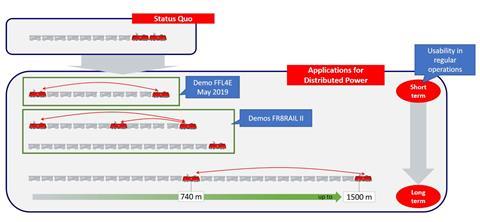
EUROPE: Initial results have confirmed the feasibility of operating long freight trains with distributed power using LTE technology, and the potential for significant cost savings.

Funded as part of the Shift2Rail FR8RAIL II research initiative, the two-year Marathon2Operation project concluded with trial runs over nine days. The test train consisted of three locomotives matched with 32 wagons of four different types plus a data recording and measurement car. A Class 188 Traxx MS3 and two Class 187 AC3 locomotives were provided as traction, with one of the Class 187s marshalled in the middle of the train and the other locos at either end.
Having been put together at the Deutsche Bahn research centre in Minden, the train spent four days operating on normal tracks across the DB network before starting three days of trials on the steeply-graded line between Probstzella and Hochstadt-Marktzeuln near Lichtenfels; the steepest grade on this route is 2∙7%. The main trials took place on February 23-24 with the 650 m long train making two runs a day in each direction. Two further days of trials followed as the train returned to Minden.
Learning a lot
Project Manager Niels Weigelt of DB Cargo who led the Work Package on Long Trains within FR8RAIL II said ‘we learned a lot about distributed power systems in normal and degraded conditions about “moving radio holes” and the behaviour in different braking regimes’. In-train forces were as expected, he explained, adding that radio coverage was better than expected, the ‘radio hole generator’ worked perfectly and the overall system behaviour was good.
Site testing included the assessing availability of radio communication based on LTE along the route, confirming the latency time for the transmission and the implementation of orders from the lead locomotive to the mid-train and rear traction units. The chosen distributed power architecture is designed to be ‘FRCMS-ready’.
Preliminary analysis and simulations had allowed a list of safety requirements for long trains to be drawn up using the technical characteristics of the equipment involved and the operational processes required. A hazard log was elaborated, informing an analysis of the safety of the train when radio connection was ― or was not ― functioning correctly. A list of mitigation actions was also prepared to deal with situations when some requirements could not be met directly by the equipment in use.
The research and subsequent trials confirmed a potential 30% reduction in operating costs from the safe operation of long trains using distributed power with GSM-R or LTE. Anticipated advantages include better use of available capacity on the network and the ability to cope with unexpected surges of traffic by using longer trains. The research team noted that terminals could be adapted without major investment, as trains can be split and joined quickly. However, some sidings and loops on routes served by long trains would need to be lengthened.

From research to deployment
The trials represented the culmination of research as part of the Marathon2Operation programme covering radio communication and simulation of train dynamics for distributed power within long trains. The project forms parted of the FR8RAIL II programme focusing on the development of distributed power, including safety management and in-train forces.
Work is to continue in 2021-23 as FR8RAIL IV, which will develop plans for regular operation. This will include rules for operators and infrastructure managers and a migration concept, plus the development of a 1 500 m demonstration train.
Partners in the €600 000 M2O project included Funkwerk which supplied the LTE modules, and Faiveley, which was responsible for the distributed brake controls. Other partners were Newopera Aisbl, the International Union of Railways, and engineering consultancy Nier Ingegneria SpA. The project co-ordinator was Università degli Studi di Roma ‘Tor Vergata’ which has been working on the TrainDy package for the computation of train dynamics since 2001.

















